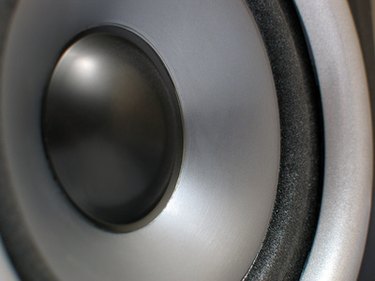
Depending on how your speaker has broken, repairing it to fully functional use may or may not be possible. Particularly when the cone or wall of the speaker blows out, often it simply isn't possible to fully repair the damage done to the speaker. However, if you don't have the money or the time to go out and buy a new speaker, there are a few things that can, at least temporarily, repair your broken speaker.
Locating and Repairing the Damage
Video of the Day
Step 1

Run your finger along the outer most rim of the speaker to check for any sign of a tear or hole in the material. Particularly with cones made of paper—rather than Kevlar or rubber, tears can occur along this rim if you are not careful about the volume which you play your speakers at. Although blown speakers typically require professional re-coning in order to achieve a perfect repair, you can temporarily repair a small tear in the cone by covering the hole with a piece of strong adhesive tape such as duct tape. To achieve the best possible repair, make sure the tape seals the hole as completely as possible.
Video of the Day
Step 2
Look behind the speaker's large magnet—opposite the large face of the speaker— for the two wires that run between the speaker's terminal and its cones. If either of these wires has been pulled loose from their connection, they can cause the speaker to work poorly or not work at all. You can repair a loose wire on the speaker by soldering it back into its place on the speaker. The wire should connect one end to the terminal of the speaker—typically designed as a metal tab, and the other end to the surface of the speaker's cone.
Step 3
Look behind the speaker's cone where its wide face connects to the magnet, and check along the edges of the reflexive paper for any sign of a tear. If any part of the reflexive paper has torn, it can cause the speaker to produce distorted, unclear sound quality. As in Step 1, a tear in this part of the speaker generally requires professional re-coning in order to be restored to fully performance capacity, but you can at least temporarily repair the tear by covering it with duct tape. Again, to achieve the best possible results, do your best to make sure the tape seals the hole as thoroughly as possible.